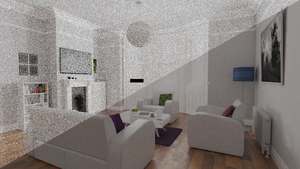Information
- Publication Type: Bachelor Thesis
- Workgroup(s)/Project(s):
- Date: September 2017
- Date (Start): 23. May 2017
- Date (End): 3. September 2017
- Matrikelnummer: 01328690
- First Supervisor:
- Keywords: physically based rendering, Monte Carlo rendering, bidirectional path tracing, probabilistic connections for bidirectional path tracing, Mitsuba, importance sampling
Abstract
Light transport simulation algorithms are remarkably adept at recreating a large variety of light phenomena which occur in nature. As such they have seen widespread adoption across the industry, which made it paramount to create efficient and robust algorithms. One recent algorithm which tries to deal with this problem is known as Probabilistic Connections for Bidirectional Path Tracing (PCBPT). It builds upon the classical Bidirectional Path Tracing (BDPT) algorithm. In Bidirectional Path Tracing, a ray is traced from the sensor as well as from the emitter. The two rays are then connected to calculate the light contribution to image pixels. PCBPT extends this idea to support connecting multiple emitter paths to one sensor subpath, and introduces importance sampling as a way of choosing the most suitable emitter paths. Unfortunately, there was no implementation of PCBPT publically available, which is why we implemented it into the open-source Mitsuba renderer. We evaluate the algorithm against standard BDPT on a variety of different scenes. Our comparisons provide insight into what type of scenes PCBPT can help improve and where the additional computational cost presents too much of an overhead.Additional Files and Images
Additional images and videos
 teaser:
Equal time comparison of the inner paths of BDPT (top-left) and PCBPT (bottom-right). PCBPT produces significantly less noise than BDPT due to importance sampling connections.
teaser:
Equal time comparison of the inner paths of BDPT (top-left) and PCBPT (bottom-right). PCBPT produces significantly less noise than BDPT due to importance sampling connections.
Additional files
Weblinks
BibTeX
@bachelorsthesis{dodik-2017-pcbpt,
title = "Implementing Probabilistic Connections for Bidirectional
Path Tracing in the Mitsuba Renderer",
author = "Nikola Dodik",
year = "2017",
abstract = "Light transport simulation algorithms are remarkably adept
at recreating a large variety of light phenomena which occur
in nature. As such they have seen widespread adoption across
the industry, which made it paramount to create efficient
and robust algorithms. One recent algorithm which tries to
deal with this problem is known as Probabilistic Connections
for Bidirectional Path Tracing (PCBPT). It builds upon the
classical Bidirectional Path Tracing (BDPT) algorithm. In
Bidirectional Path Tracing, a ray is traced from the sensor
as well as from the emitter. The two rays are then connected
to calculate the light contribution to image pixels. PCBPT
extends this idea to support connecting multiple emitter
paths to one sensor subpath, and introduces importance
sampling as a way of choosing the most suitable emitter
paths. Unfortunately, there was no implementation of PCBPT
publically available, which is why we implemented it into
the open-source Mitsuba renderer. We evaluate the algorithm
against standard BDPT on a variety of different scenes. Our
comparisons provide insight into what type of scenes PCBPT
can help improve and where the additional computational cost
presents too much of an overhead.",
month = sep,
address = "Favoritenstrasse 9-11/E193-02, A-1040 Vienna, Austria",
school = "Institute of Computer Graphics and Algorithms, Vienna
University of Technology ",
keywords = "physically based rendering, Monte Carlo rendering,
bidirectional path tracing, probabilistic connections for
bidirectional path tracing, Mitsuba, importance sampling",
URL = "https://www.cg.tuwien.ac.at/research/publications/2017/dodik-2017-pcbpt/",
}

 thesis
thesis
